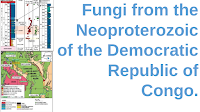Although generally thought of as terrestrial organisms, Fungi are an integral part of marine, freshwater, and wet terrestrial ecosystems, helping to break down dead organic tissue, and in particular wood. The genus Menisporopsis contains 13 species of marine and freshwater Ascomycote Fungi producing pigmented, synnematous conidiophores (cylindrical asexual spores). The genus was first described in 1952 to describe a Fungus found growing on rotting Cocoa leaves in Ghana.
In a paper published in the Biodiversity Data Journal on 21 October 2022, Jia-Hao Chen of Jiangxi Agricultural University, Dian-Ming Hu, also of Jiangxi Agricultural University, and of the Jiangxi Environmental Engineering Vocational College, and Hai-Yan Song, Zhi-Jun Zhai, Lin La, and Kang-Hui Lin, also of Jiangxi Agricultural University, describe a new species of Menisporopsis found growing on submerged wood in a brook in Zhejiang Province, China.
The new species was established as such using a molecular phylogeny based upon a combined two-loci dataset, including the internal transcribed spacer sequences and the nuclear ribosomal large subunit gene sequences. This found the new species to be nested within the Menisporopsis clade, forming a sister group to the branch comprising Menisporopsis breviseta and Menisporopsis pandanicola, with Menisporopsis dushanensis forming the sister group to all three of these species. Having been established as a new species, the Fungus was named Menisporopsis aquatica in reference to its freshwater habitat.
Menisporopsis aquatica was found growing on submerged wood in the Qianjia Lou Brook near the town of Daoxu in Shangyu District. The Fungus forms a pale yellow to pale brown branching mycelium. It produces black setae, which are surrounded by tightly packed brown conidiophores.
 Menisporopsis aquatica (HFJAU 10038, Holotype) (a)-(b) conidiophores and conidia on
submerged wood; (c) conidiophores with seta; (d) apex of the conidiophore with developing
conidia; (e) base of the conidiophore; (f) seta; (g)-(j) conidia; (k) colony on Potato
dextrose agar. Scale bars: (a)-(b), 100 µm; (c), 50 µm; (d)-(j), 10 µm. Chen et al. (2022).
Menisporopsis aquatica (HFJAU 10038, Holotype) (a)-(b) conidiophores and conidia on
submerged wood; (c) conidiophores with seta; (d) apex of the conidiophore with developing
conidia; (e) base of the conidiophore; (f) seta; (g)-(j) conidia; (k) colony on Potato
dextrose agar. Scale bars: (a)-(b), 100 µm; (c), 50 µm; (d)-(j), 10 µm. Chen et al. (2022).See also...
Follow Sciency Thoughts on Facebook.
Follow Sciency Thoughts on Twitter.







